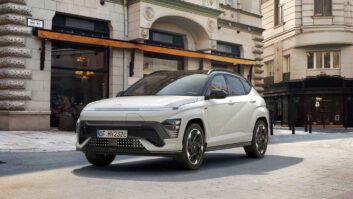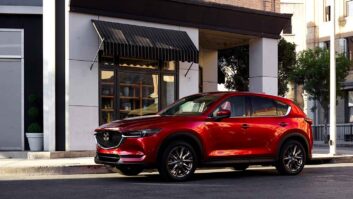Cars that are powered by electricity, wholly or in part, now account for more than a third of all new models sold in the UK. Electric vehicles of all kinds are firmly established in the motoring mainstream. If we discount mild hybrids (which don’t use electricity to directly power the car), there are three main types of electrified car: hybrids (HEVs), plug-in hybrids (PHEVs), and battery electric vehicles (BEVs).
The best cars for towing a caravan will always provide plenty of stability and practicality, ensuring you and your tourer safely arrive at your destination.
If you’re thinking of getting a HEV, a PHEV or a BEV, it’s worth being aware that there are pros and cons to each type when it comes to everyday driving, as well as advantages and disadvantages that are specific to towing.
Caravanners don’t tend to be the kind of people to change for change’s sake, but as the technologies continue to mature, they offer improved performance, greater efficiency and longer range. So is now the time to switch to an electrified option when you’re choosing a tow car? What are the pros and cons of the three main kinds of electric drivetrain, hybrid, plug-in hybrid and battery electric vehicles?
Don’t forget the importance of safely matching a car to a caravan when you’re picking the right vehicle too.
Hybrid vehicles
A HEV (sometimes also called a full or self-charging hybrid) uses both an internal combustion engine and an electric motor. At any given time, it may rely on the engine, the motor or a combination of both.
For anyone who might be considering changing from a conventionally powered car, a straightforward hybrid takes the least adjustment. In fact, HEVs are little different from any automatic car to drive.
There’s no plugging in, as instead, the battery is recharged using energy that would otherwise be lost under braking or by employing the engine as a generator.
Compared with plug-ins, full hybrids won’t go as far on electricity alone. They have much smaller batteries, which don’t support driving tens of miles without using the engine as well. But they are usually significantly cheaper than the plug-in hybrid equivalent.

Take the Kia Sportage, which is available as a HEV and a PHEV. The regular hybrid model is priced from £35,375. The plug-in hybrid costs £40,575. Few buyers can hope to recoup the £5000+ price difference in fuel savings.
Early hybrids were rarely approved for towing, but now, many petrol-electric cars have healthy maximum towing figures. For example, the Kia Sportage HEV 2WD is approved to tow up to 1500kg. The new 2024 Ford Kuga hybrid has a maximum towing figure of 1600kg.
The best hybrid cars for towing make excellent tow cars. The electric motor provides instant response from standstill, which makes for confident hill starts, while the petrol engine delivers top-end power. In a well-built hybrid, the power sources complement each other.
Even towing, it’s surprising how often a HEV can run on electricity. According to the on-board computer in the Ford Kuga we tested in 2022, it completed 14% of its towing mileage on battery power, returning an impressive 30.7mpg.
Plug-in hybrid vehicles
A PHEV is similar to a hybrid, but you can plug it in to recharge the battery. That’s necessary because the battery in a PHEV is typically much larger than that of a HEV, giving a more significant all-electric range. About 30 miles is typical, but some of the latest models get closer to 50 or 60 miles.
The best plug-in hybrid tow cars work superbly if you can complete your typical daily driving using electricity alone, but with the convenience of petrol or diesel refuelling for long trips. For the right type of owner, this is going to be the best of both worlds.
For the wrong type of owner, PHEVs are heavy and overpriced, and will underachieve compared with the official economy figures. Anyone who runs a PHEV but does not have convenient charging at home or work will struggle to get anywhere close to the fuel efficiency these cars are capable of.

On a long towing journey, PHEVs tend to be extremely economical for the first few miles, then economy worsens significantly once the all-electric range is zero.
In a towing test last year, the Volvo V60 PHEV achieved 165.4mpg while the battery had a healthy charge, dropping to 24.2mpg once the electric range was zero.
It’s a mistake to think the battery will run completely flat. A PHEV will maintain some charge through regenerative braking or using the engine as a generator.
Battery electric vehicles
In many ways, BEVs tow superbly. They are very heavy, and the weight is usually kept low to the ground, which benefits stability. With very high power and torque figures, many BEVs will cope easily with towing, as was the case with the Nissan Ariya E-4orce Evolve I tested recently.
However, while acceleration and stability are, as a rule, excellent, other aspects of towing with a BEV are more problematic.
As a very rough rule of thumb, you can expect the range of a BEV to halve when you are towing a caravan. Clearly, that will vary depending on the car and the size and weight of the caravan, but that’s been our experience. Most of the BEVs we’ve tested have been capable of travelling 100-130 miles before a full recharge is needed.
Stopping every couple of hours isn’t too much of an irritation – it’s considered best practice to stop once every two hours or so to avoid fatigue.

However, a full recharge could take an hour or more, depending on the battery size and the power of the charger. So you could spend around half your total journey time with the vehicle on charge.
Then there’s the additional problem that currently, very few charging bays are designed for a car that is towing a caravan or trailer. You will need to find somewhere to park the caravan and lock it securely before taking the car to the charge point, all adding time and inconvenience.
Despite the naysayers, most credible studies suggest that BEVs have the lowest carbon footprint over the full life of the vehicle. However, unless you stay local when you tow, owning an electric tow car requires patience and forward planning.
The final word on a hybrid, plug-in hybrid or electric
If you are committed to lowering your carbon dioxide emissions and relish the challenge of towing with an electric car, a BEV is going to be the greenest choice over the lifetime of the vehicle.
However, until the charging network is truly geared up for drivers with caravans, horseboxes and trailers, towing with a BEV demands true commitment to the cause.
HEVs and PHEVs are both easier to live with on a long towing journey. Choosing between the two types is partly a matter of budget, because PHEVs are considerably more expensive than hybrids.
It’s also a question of whether you have space to recharge the vehicle at home. Without a charger on the driveway or in your garage, it’s difficult to make the sums add up in favour of a PHEV.
That being the case, for the next few years, a hybrid and a plug-in hybrid are more practical than battery electric vehicles for caravanners looking to switch to electrified towing.
After buying your new car, you’ll be able to think about where you want to go in it – a piece of kit that can take the stress out of your journey is one of the best caravan sat navs, helping you navigate safely and avoid obstacles such as narrow roads.
If you’ve enjoyed reading this article, why not get the latest news, reviews and features delivered direct to your door or inbox every month. Take advantage of our brilliant Practical Caravan magazine SUBSCRIBERS’ OFFER and SIGN UP TO OUR NEWSLETTER for regular weekly updates on all things caravan related.









